Note: This website was automatically translated, so some terms or nuances may not be completely accurate.
Create Buzz with SNS Posts! Unraveling OOH Virality
More companies are placing OOH (Out Of Home: a collective term for advertising media encountered outside the home, such as transit ads, outdoor billboards, and ads in commercial facilities) with the goal of creating buzz on social media. When we published an article in this series titled "Visualizing 'OOH Buzz' as a New Value Metric!", it generated significant response.
The article covered:
- How social media buzz translates into OOH value
• Defining buzz
• Factors influencing buzz
• The "Buzz Prediction Model" to increase campaign success rates
(Read the full article here ).
This article provides deeper insights into what's needed to make OOH go viral on SNS and the resulting impact.
OOH Original Creatives Generate Buzz on SNS
OOH is eye-catching in advertising campaigns. It delivers visual impact to viewers and sparks conversations about products or services among friends and family. It also encourages social media discussions.
Dentsu Inc. Out-of-Home Media Division "OOH Buzz Research Team" investigated how much buzz OOH campaigns can generate within the context of overall promotions that also utilize TV and digital media.
Using social listening tools, they analyzed data from several promotions by a specific content company. They examined how much OOH contributed to generating buzz by varying the search queries (search keywords that extract only user conversations about the promotion or OOH campaign). They limited the companies because their product categories were similar, and their promotional methods were largely comparable.
OOH campaigns primarily serve two purposes: awareness-building and generating buzz. Awareness-focused campaigns typically involve exposure on highly visible OOH media in high-traffic areas, often repurposing creative assets like TV commercials or digital ad videos. While effective for building awareness, they rarely include mechanisms designed to trigger the action of taking photos and posting them on social media.
Conversely, buzz-driven OOH campaigns are designed to stand out on their own, creating dedicated OOH creative assets that spark the desire to share. The analysis results from our social listening tool are as follows:
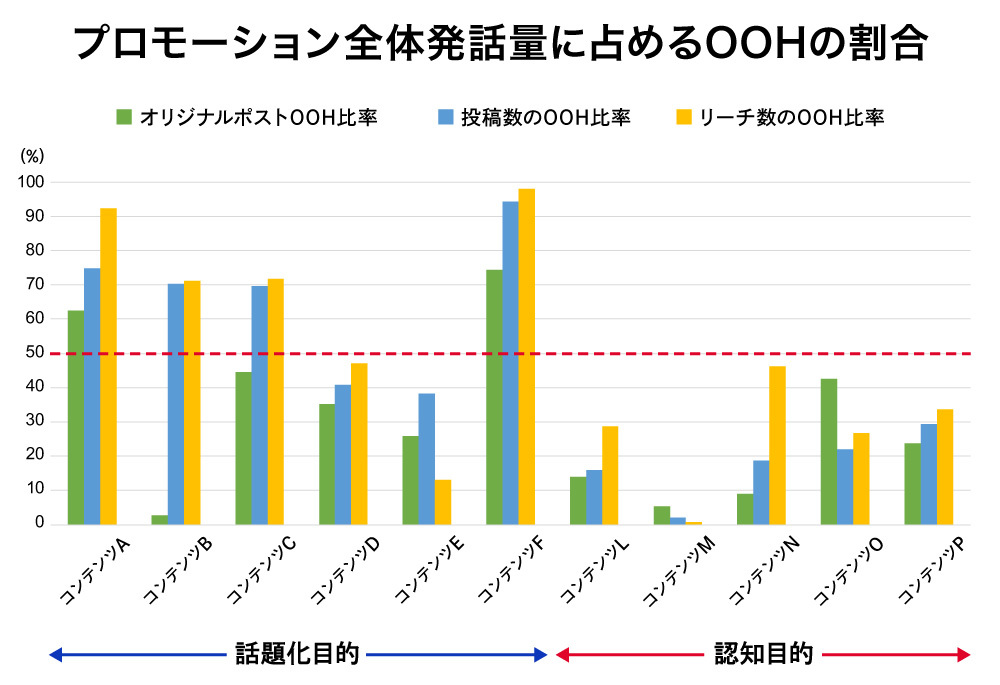
When OOH was deployed for the purpose of generating buzz, examining the volume of discourse on X (Twitter) revealed that OOH generated over half of the total discourse for multiple campaigns. Particularly for Content A-C and Content F, people were paying attention to and taking photos of the OOH creative assets produced specifically to generate buzz, leading to a significant increase in original posts (tweets).
On X (Twitter), reposting (retweeting) the advertiser's post is common during giveaway campaigns. Despite reposting being the simpler action, the high proportion of original posts indicates that OOH designed for buzz generation has the characteristic of making people want to speak about it.
Conversely, awareness-focused campaigns often show a lower rate of OOH buzz generation, with the graph indicating they tend to generate less discussion. The findings reveal that while OOH possesses the power to generate buzz, simply placing ads isn't enough. It requires strategic elements, such as creating OOH creative assets designed to spark conversation.
OOH buzz spreads through diverse sources!
What does it mean for OOH to go viral on social media? Examining OOH campaign buzz on X (Twitter) reveals three distinct cases.
- Cases where buzz is generated by advertisers or featured talent announcing the start of an OOH campaign
- Cases where buzz is generated by posts from media accounts. This allows for broader dissemination to audiences beyond the immediate community
- Cases where people who learned about the ad placement through 1 or 2, or those who happened to see the ad, discuss it. The more prevalent case 3 is, the more diverse the buzz becomes, and conversations among followers also become more active.
Getting a bit technical, we investigated whether differences in the originator and posting method affect impression differences. The results showed that ads leave a stronger impression when posted as original content by corporate accounts, followers, celebrities, or news media. This finding likely aligns with readers' experiences. Increasing original posts over reposts seems crucial.
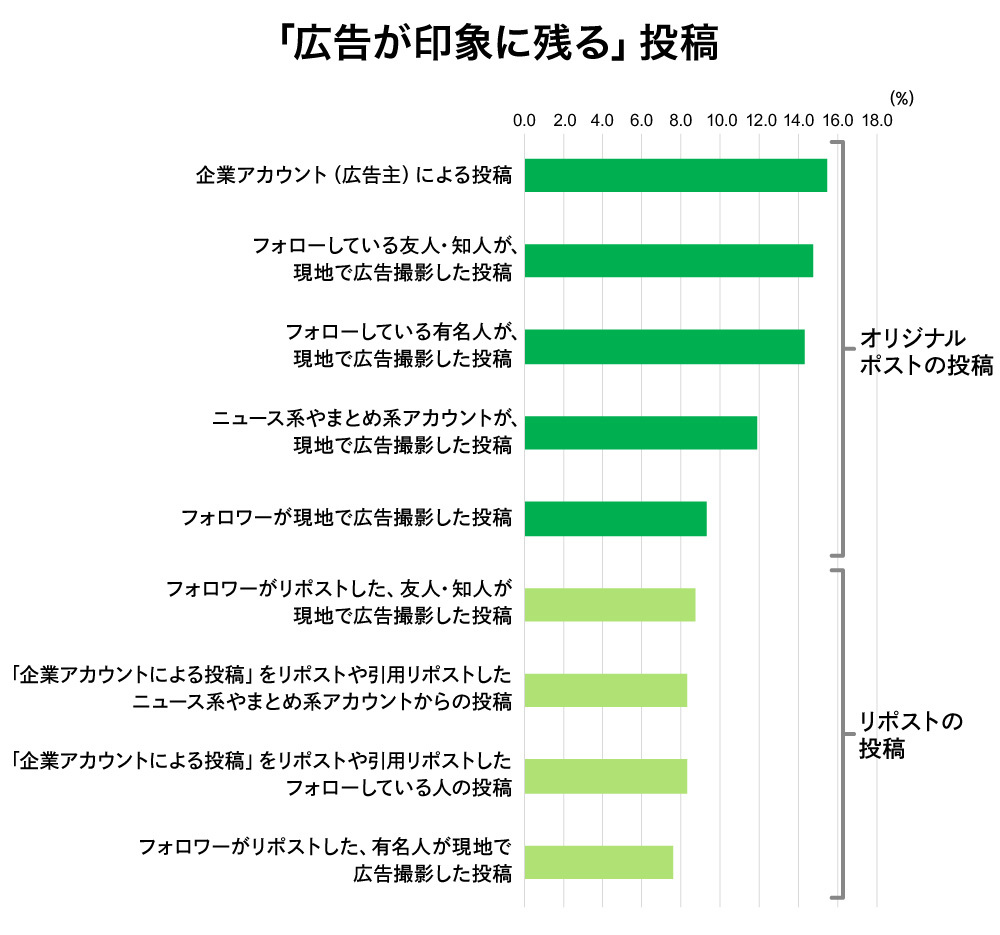
To increase the number of posts, it is effective for corporate accounts (advertisers) and accounts of featured celebrities to confirm with media outlets in advance and announce the ad placement. To increase posts from followers (general consumers), creating OOH that makes people want to post spontaneously is paramount. However, running participatory campaigns that encourage posting on SNS can sometimes lead to an explosive increase in numbers. Furthermore, to increase posts from news media, press release distribution is effective. Clearly stating the start date, location, and visual image of the ad makes it easier to communicate the information.
Furthermore, we became interested in how posts on X (Twitter) – featuring images and comments of OOH – differ from actual OOH or X (Twitter) ads, and what impressions they create. This is because OOH buzz campaigns rely on both the OOH itself and the flood of OOH posts on X (Twitter).
Therefore, we presented reference images of OOH from multiple advertising campaigns, X (Twitter) posts announcing the OOH, and X (Twitter) ads with the same content, and evaluated the impressions of each. The OOH buzz campaign is displayed as the combined effect of the OOH and the OOH posts. Below are the top 6 most common impressions regarding the OOH buzz campaign.
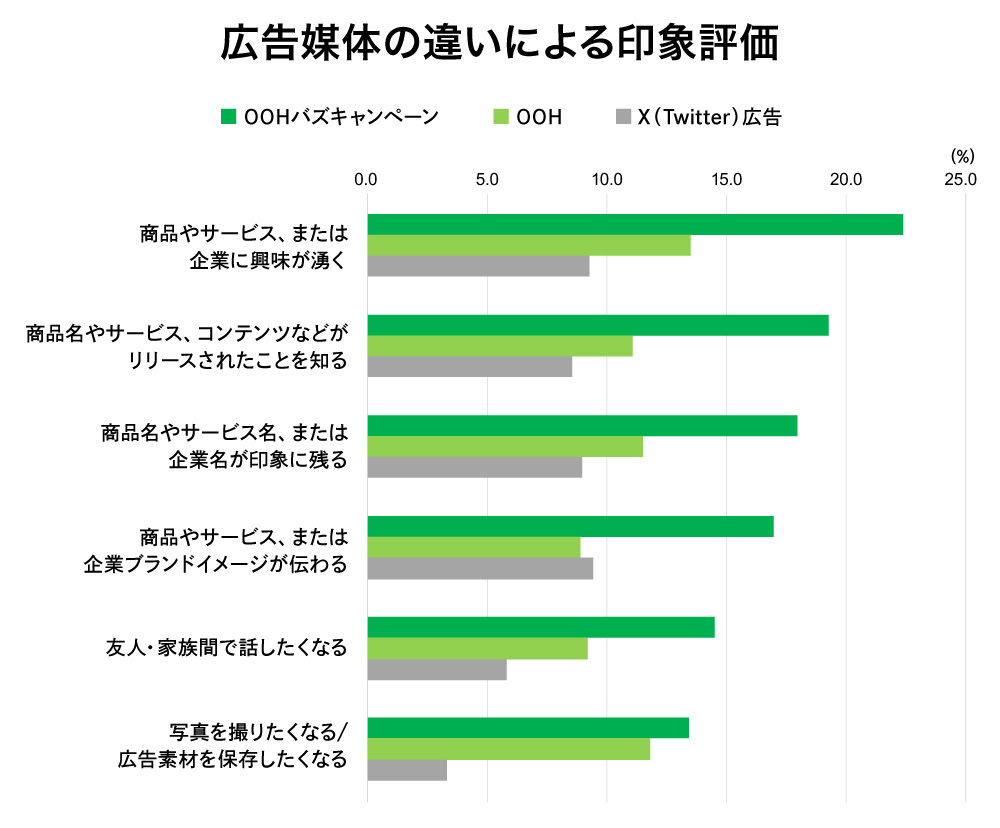
OOH advertising not only sparks interest in products, services, or companies, conveys messages, and leaves an impression, but also has the characteristic of making people want to take photos or talk about it. Buzz campaigns incorporating OOH posts further amplify these effects, demonstrating high effectiveness. In reality, OOH campaigns generate OOH posts at no cost, so the resulting advertising impressions are likely significant as a secondary benefit.
While X (Twitter) ads are characterized by their targeting capabilities, OOH buzz is notable for being shared not only by advertisers but also by people in various roles. An interesting point is that when posts spread to potential customers who haven't yet shown interest in the product or service, it can potentially elevate them to the active interest stage.
Among the impressions shown in the figure above, "wanting to take a photo/wanting to save the ad material" represents the preliminary stage before the desire to share arises. When asked why they felt this way, the following results emerged.
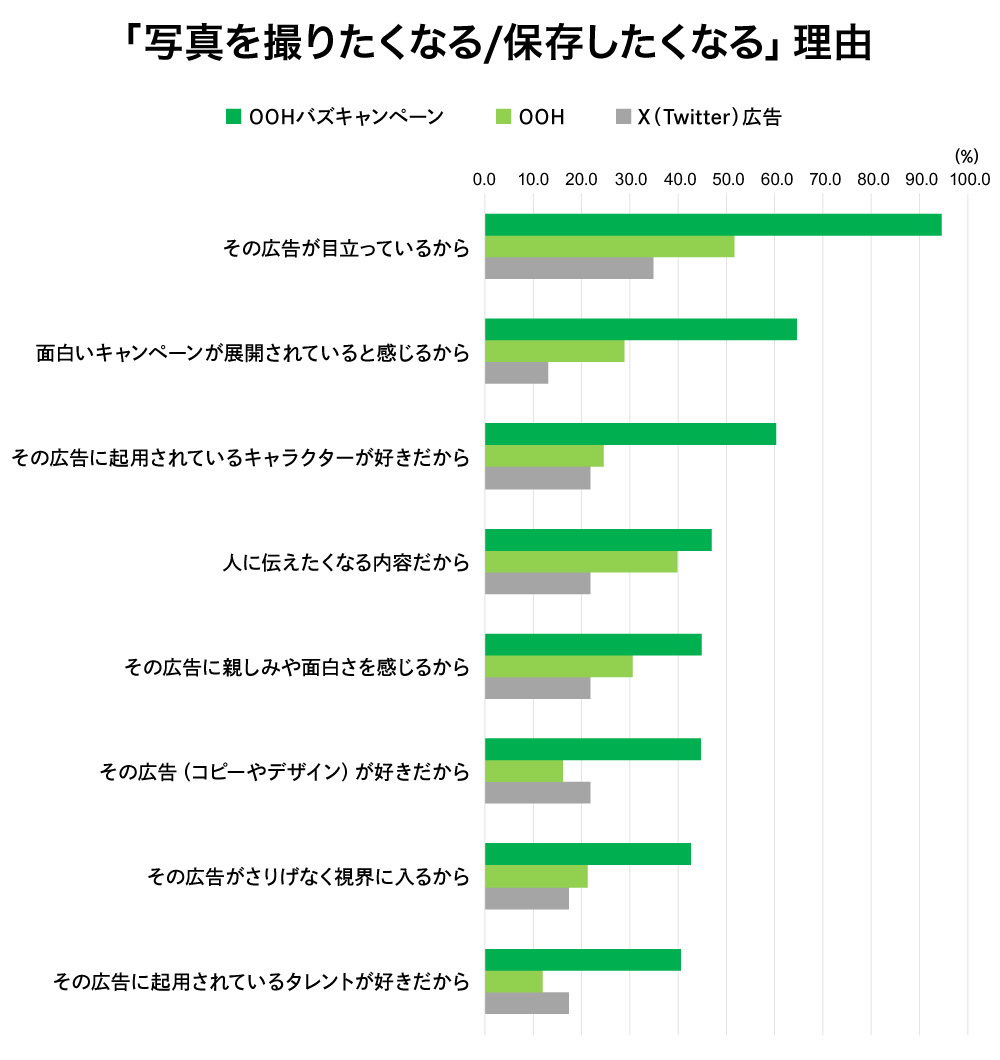
Looking at these results, we see that the main reason people take photos or save images is because they see a striking advertisement and want to tell others about it. Additionally, a high percentage cite reasons like finding it interesting or liking the ad content (talent or characters), indicating they take photos or save images for these reasons.
The buzz generated by OOH can be broadly categorized into four types
We know OOH campaigns generate buzz, but what kind of buzz do they create? We examined posts about OOH campaigns across different industries and products using mindlook®, a natural language analysis tool capable of Japanese sentiment analysis. This tool analyzes and understands consumers' "emotions" from the vast voices on social media, utilizing 81 emotion tags to classify post content.
After selecting several OOH campaigns and analyzing all related posts, we found the emotions <Gratitude/Inspiration> and <Positive/Liking> were consistently high, followed by <Requests>, <Surprise>, and <Questions>. By reviewing post content for each emotion tag, we summarized the types of buzz generated by OOH into the following four categories.
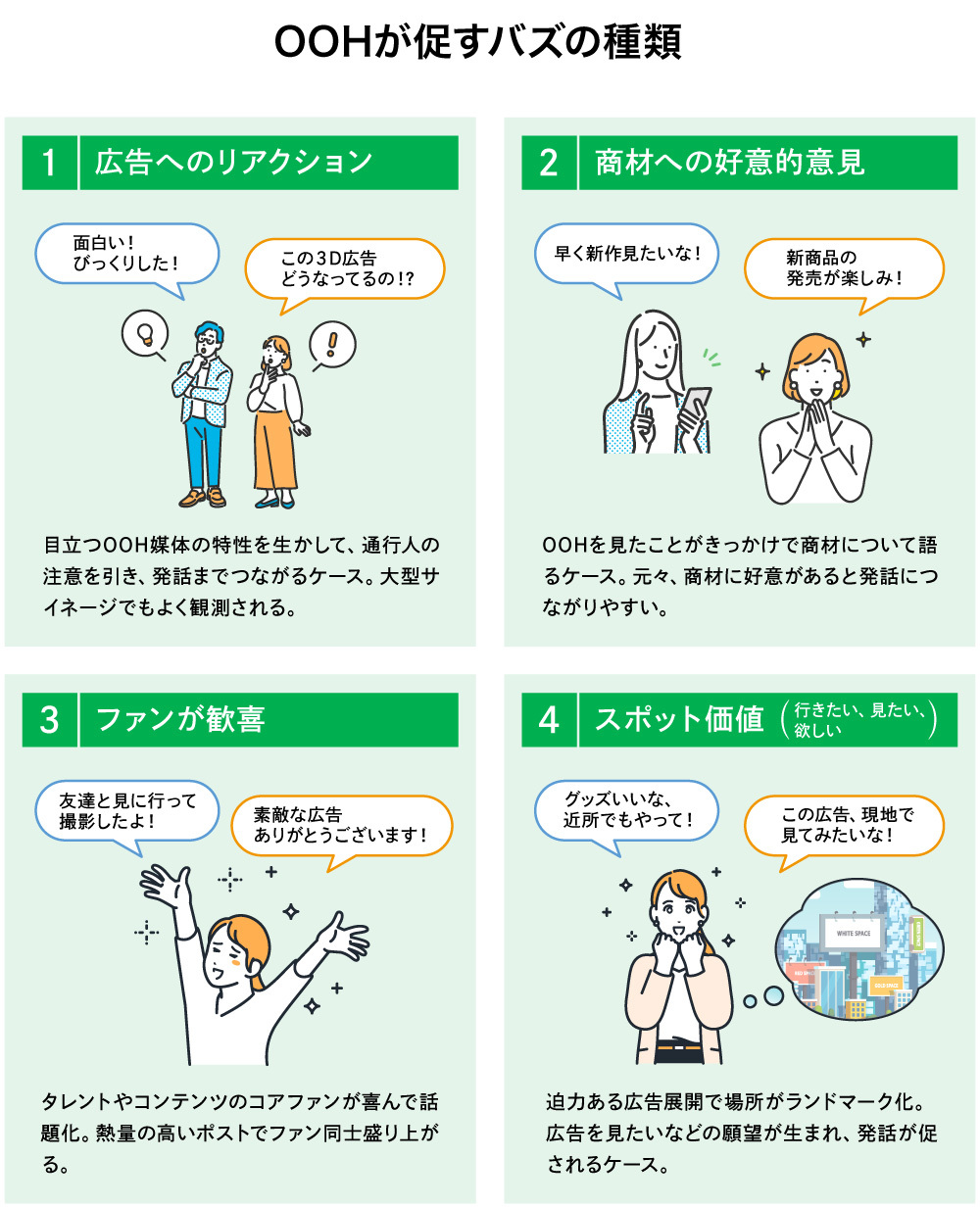
"Reactions to the Ad" included responses like "!?", "?" at the end of sentences, reflecting surprise upon seeing the ad, alongside likes or dislikes for the creative material itself.
"Positive Opinions About the Product" refers to discussions about the product itself after seeing OOH. Positive posts can be seen, such as anticipation upon learning about new product launches or releases.
"Fan Delight" refers to the buzz of gratitude and excitement generated by announcements of ad launches, information about available merchandise, and simply seeing the ad itself, revealing fans' joy. On SNS, where people with shared interests connect, ads for popular talents or content generate significant buzz. Fan posts often include photos and videos; fans take great angles to share their favorite's image, resulting in many high-quality photos that rival professional work. Participatory campaigns that encourage users to collaborate—like prompting everyone to find the ad location together, solving puzzles, or cooperating with other users—tend to be successful.
Finally, "spot value" refers to the desires drawn out by the location itself. As a place becomes a landmark, it sparks various wishes: wanting to see the ad displayed, desiring the bonus goods, or hoping for displays in nearby areas.
Many people consider not only mass media ads but also the opinions of friends and acquaintances, or social media buzz, when deciding to purchase a product or getting that final push. As seen on X (Twitter), where many respondents said posts from friends and acquaintances left a stronger impression than those from followed celebrities, the opinions of ordinary people are valuable. While hiring influencers to create buzz is one way to increase word-of-mouth, OOH excels at getting ordinary people to find it interesting and spontaneously post about it.
Thus, OOH not only increases awareness among targets that TV commercials struggle to reach, but also generates positive conversations about products and brands on social media. This helps boost product awareness and understanding via social channels.
This time, we explored OOH buzz: how much buzz it generates, what people feel and talk about, and how those around them perceive it.
It's said that to move people through advertising, you need to evoke either "liking" or "surprise" in the viewer. Our research confirmed this precisely. OOH, with its ability to create powerful displays in public spaces, is particularly effective at eliciting these emotions. Our "OOH Buzz Research Team" will continue to unravel the buzz of OOH.

Was this article helpful?
Newsletter registration is here
We select and publish important news every day
For inquiries about this article
Back Numbers
Author

Kana Misawa
Dentsu Inc.
Out-of-Home Media Division
After working in creative, sports business, AI chatbot, and healthcare business development, he assumed his current position. He is involved in developing media planning tools centered on OOH and business development in the data and technology domain. Ph.D. (Interdisciplinary Information Studies)


